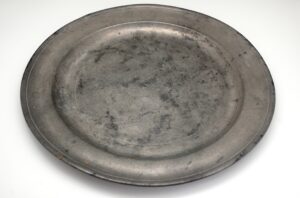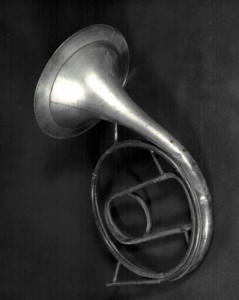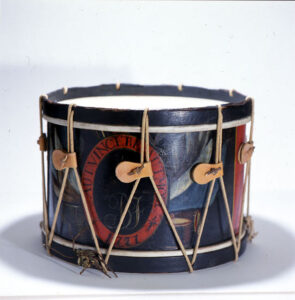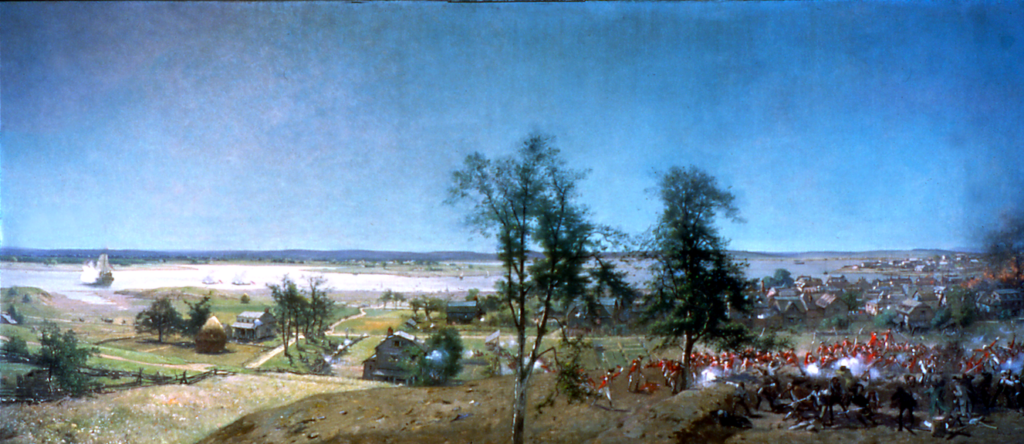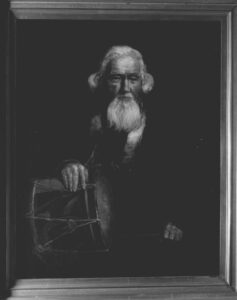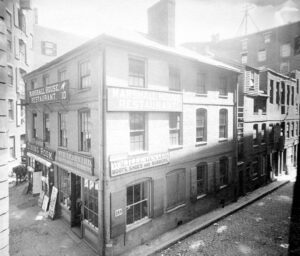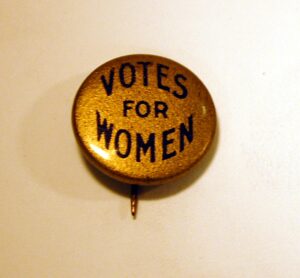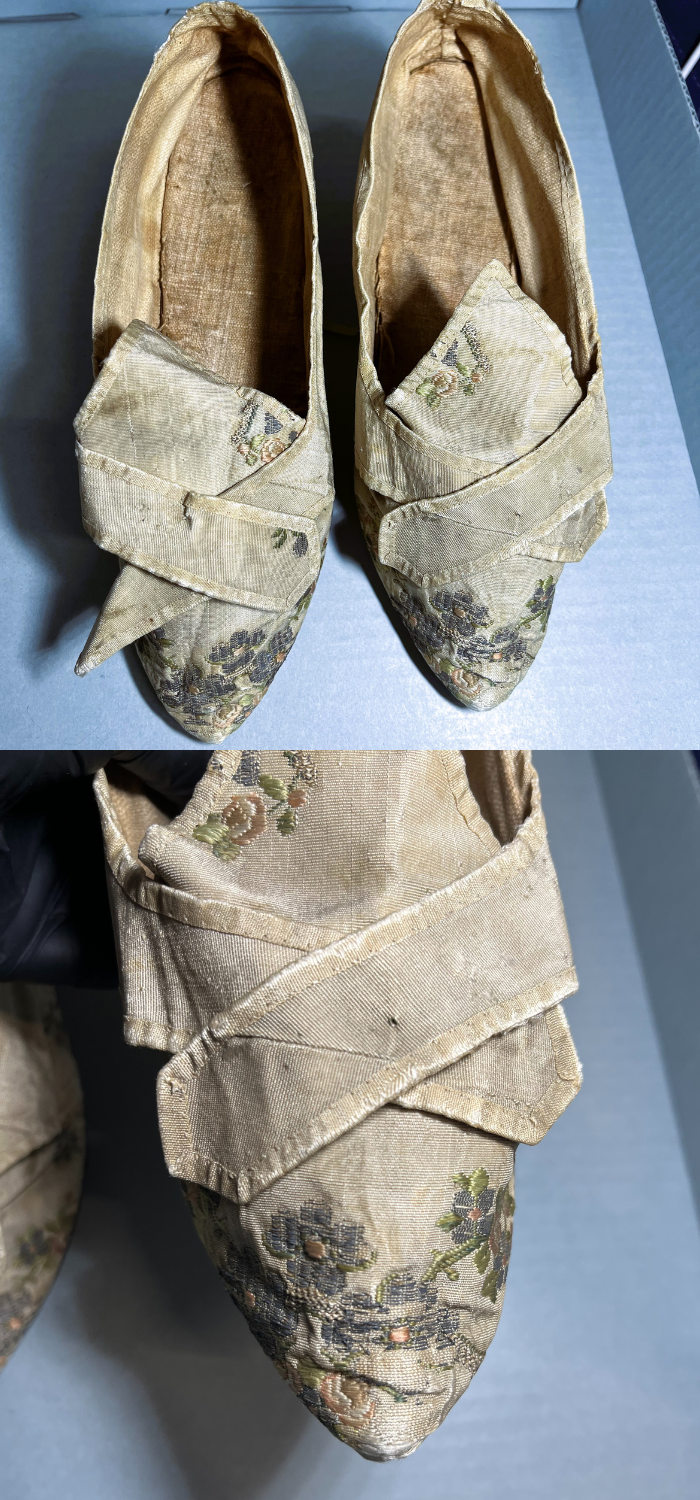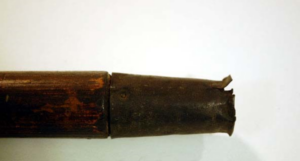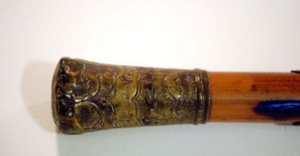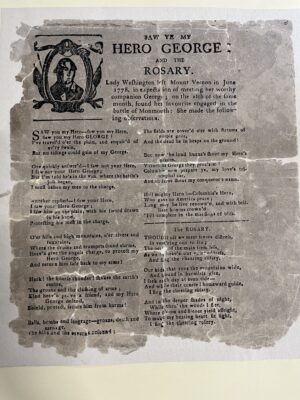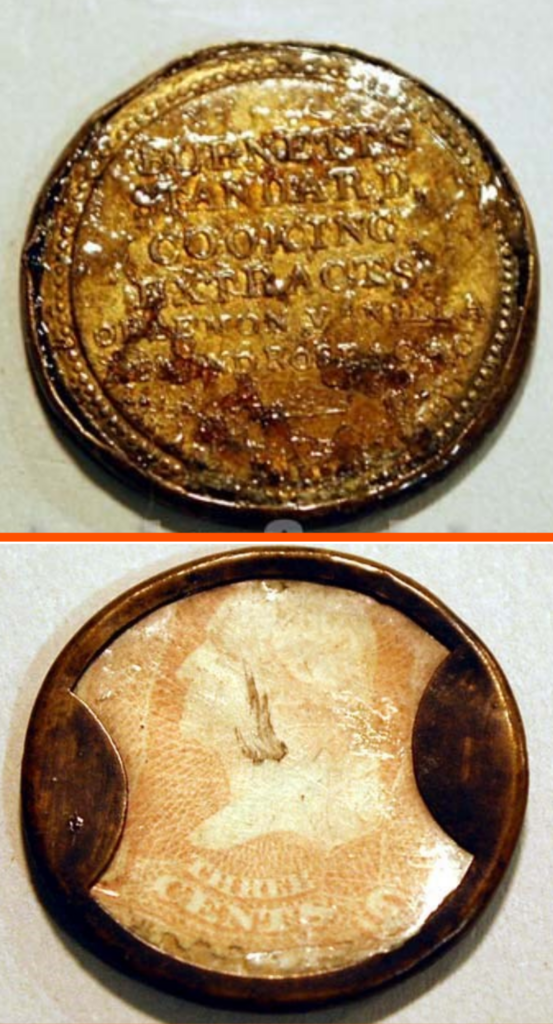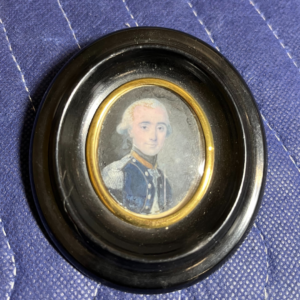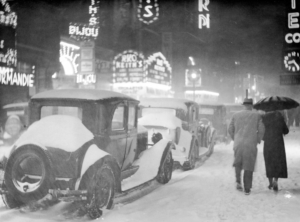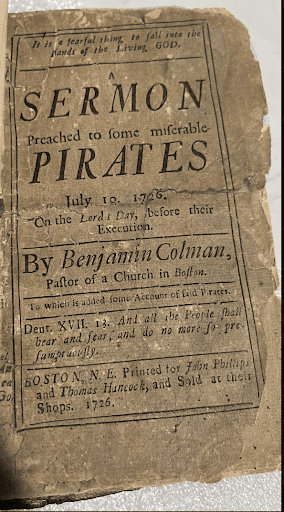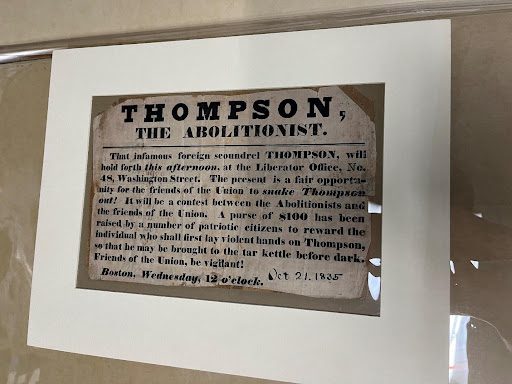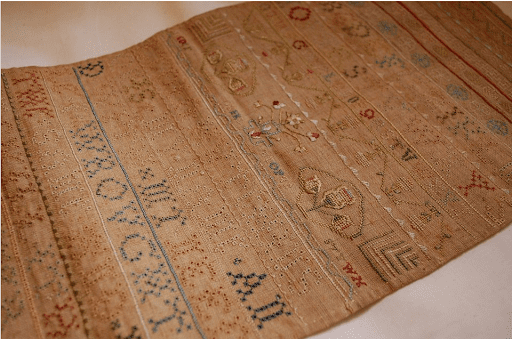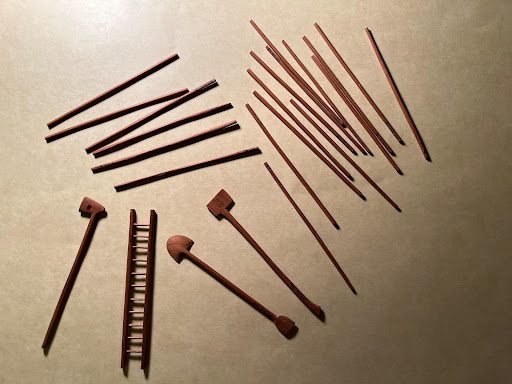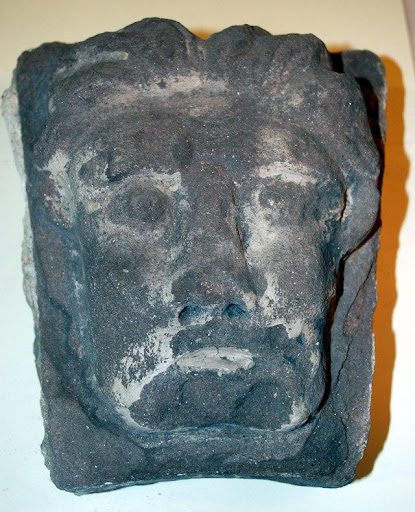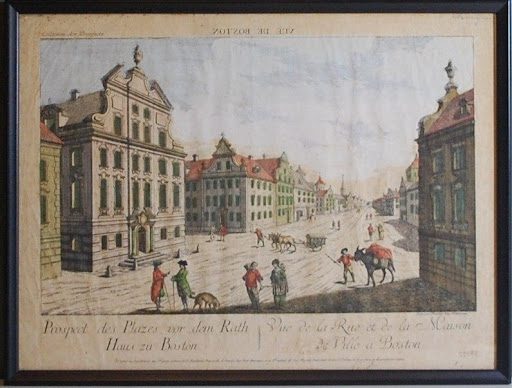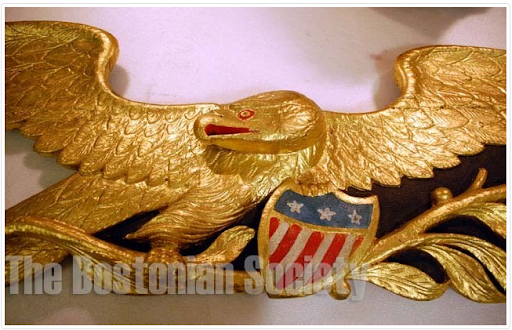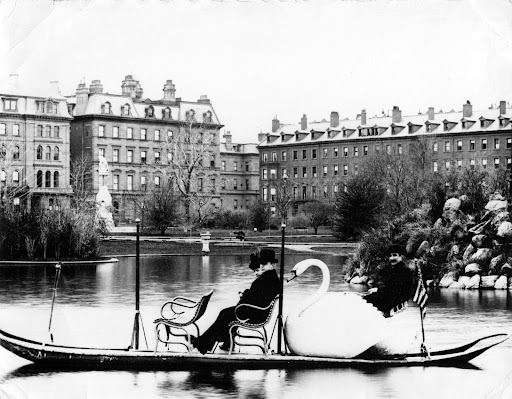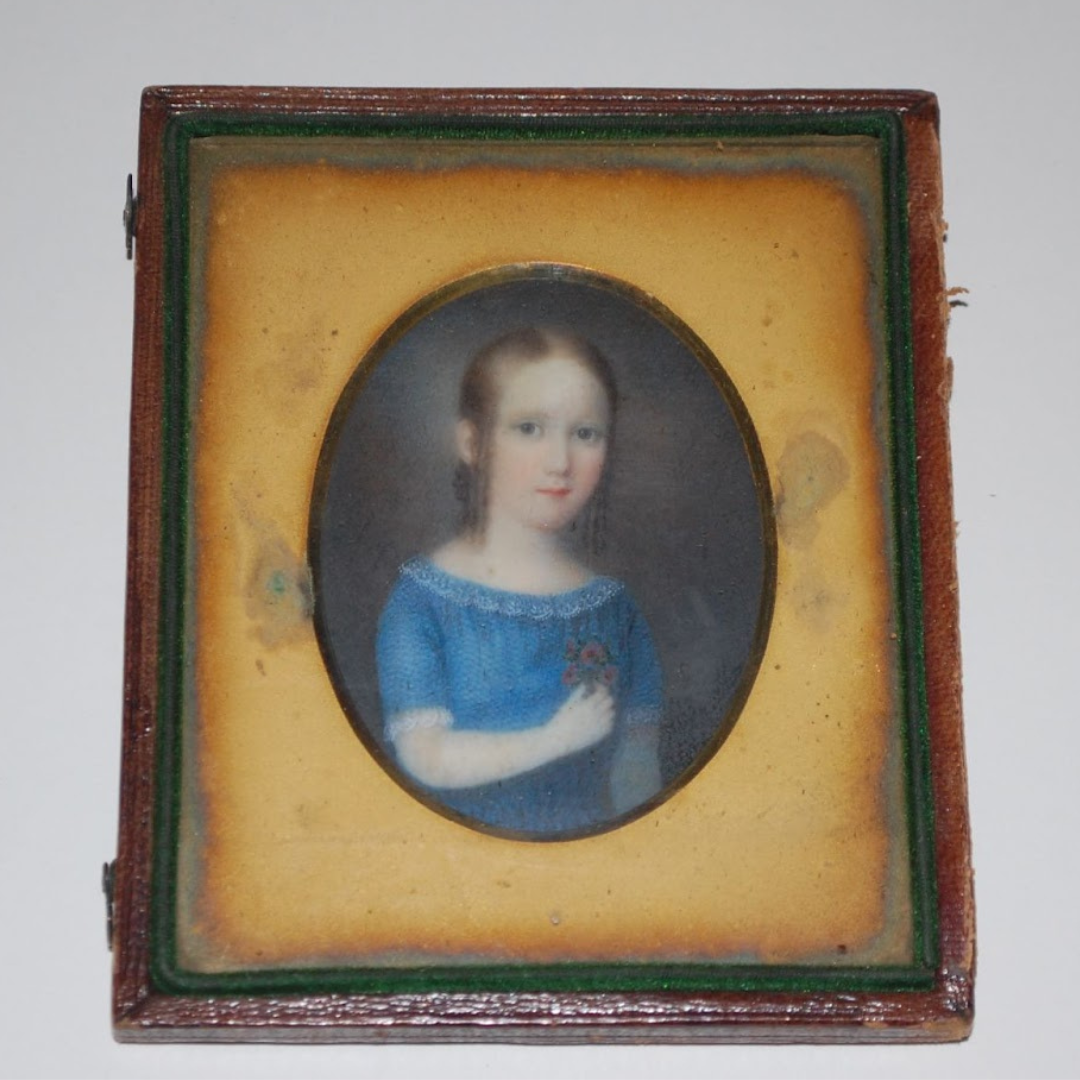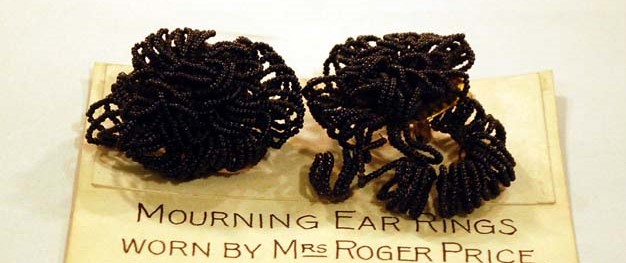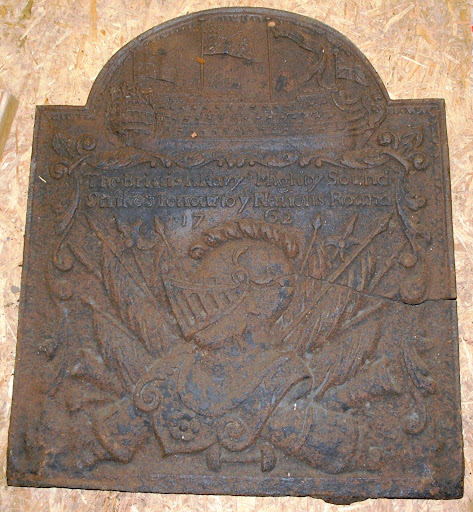


Explore Revolutionary Spaces' Object of the Month to learn more about our collection of objects, documents, maps, books, photographs, and more! Each month, we will highlight a unique object handpicked by Associate Director of Collections Lori Erickson Fidler. Discover some of the unique and interesting items from the past 400 years of regional and national history, spanning the seventeenth to the twentieth centuries.
Want to know our next object of the month? Sign up for our email list today!
Read more about the Object of the Month by selecting a month below. Click on the object to view an enlarged image.
2025 Objects of the Month
January 2025 - Jeffrey Hartwell's Pewter Plate
c. 1775
1895.0039.001
This month’s post features one of three pewter plates in the collection which belonged to Jeffrey Hartwell, a Black man who was born into slavery around 1751 and served at some of the most important battles of the Revolutionary War. Hartwell fought at the Battle of Bunker Hill, having been forced to serve in place of his master. He later enlisted of his own accord in September 1777 and was discharged a few months later. He then re-enlisted in June 1778 and is known to have been stationed at West Point, NY by December 1778. He is believed to have served at the Battle of Saratoga, one of the turning points of the war.
By March 1779, Hartwell was free and living in Dracut, MA. He married a free woman named Maria, who had also been born into slavery, and they were gifted two acres as a wedding present from Maria’s employer. Jeffrey and Maria had six children, four of whom lived to adulthood. Hartwell died in Dracut on 22 July, 1816 at the age of 75 and is buried in the Hamblett Cemetery in Lowell.
Click here to view this object in our collection.
February 2025 - Engraved Busk
c. 1850
MB0366
During the 1600s and continuing into the 1900s, women typically wore corsets, also known as “stays,” to shape their waists and provide structure to their dresses. The boning that gave the corset its rigidity was usually made of whale baleen, a material made of keratin (also found in human fingernails). Baleen is found in certain species of whales and acts as a filter for the food ingested into the whale’s mouth. In the seventeenth century, sailors began to carve busks—thin flat objects made of wood, ivory, or bone—for their sweethearts. These love tokens would be slid into the corset, so the young woman could wear the carving close to her heart. This example, made of whale ivory, features a merman, heart, leaves, and geometric designs.
Click here to view this object in our collection.
March 2025 - French Horn owned by Lorenzo Papanti
c. 1781
1908.0016
Lorenzo Papanti was born in Livorno, Italy in the early 1800s. He served in the Royal Guard for the Duke of Tuscany until he killed another officer in a duel and was forced to flee the country. Escaping onto the US Frigate Constitution while it was docked in an Italian port, he was given a position as a French horn player in the ship’s band. He sailed to the United States, settling in Boston, where he became a highly esteemed dance master. Over the years, he taught many in Boston’s high society to waltz and polka and hosted elaborate balls at his beautiful state-of-the-art ballroom on Tremont Street.
Click here to view this object in our collection.
April 2025 - Drum used at the Battle of Bunker Hill
1775
Paint, leather, wood, and rope
1883.0114
This year marks the 250-year anniversary of the Battle of Bunker Hill, the first major battle of the Revolutionary War. Many who fought were local residents, coming from the Boston area and other parts of New England to heed the call for patriots at the Charlestown conflict. Though only thirteen years old at the time, John Robbins of Acton joined the heroic stand, acting as drummer to mark time for the marching troops. Robbins also acted as a messenger during the war, including bringing news of the British march to Lexington to Acton’s Minutemen Company.
Click here to view this object in our collection.
May 2025 - Bunker Hill Cyclorama Sketch Murals
c. 1884
Oil on canvas
1960.0013.001-003
A late nineteenth century invention, cycloramas were an innovative way to allow visitors to experience the feel of a historic event. Intended to create a sense of action, the cyclorama featured several large murals arranged in a circular room. Visitors would move from one scene to the next, to see the progression of an event such as a battle. The Battle of Bunker Hill Cyclorama was located on Tremont Street in Boston’s South End. The three Cyclorama paintings in Revolutionary Spaces’ collection were used as preliminary studies for the murals that eventually went on display.
More information about the unique attraction can be found here: Mystery of the Lost "Battle of Bunker Hill Cyclorama" (U.S. National Park Service)
Click here to view this object in our collection.
June 2025 - Portrait of Daniel Simpson
c. 19th century
Darius Cobb
Oil on canvas
1883.0113
April’s Object of the Month featured a drum used by John Robbins at the Battle of Bunker Hill, but this instrument actually appears in the Revolutionary Spaces collection more than one time. This portrait of Daniel Simpson (1790-1886) shows the same drum resting on his knee. John Robbins passed the drum on to Simpson, who used it during his service in the New England Guard in the War of 1812. Robbins is also recorded as having been the only drummer present at Boston’s Broad Street Riot in 1837, but it’s unclear if he used the Robbins drum at this conflict as well.
Click here to view this object in our collection.
July 2025 - Ebenezer Hancock House
C. 1900
Albumen print
VW.0001.000790
In honor of the Ebenezer Hancock House being put up for sale, this month we’re highlighting a 20th century photo of this off-the-Freedom-Trail find! The house was built in 1767 and financed by John Hancock, but his younger brother Ebenezer lived and worked there. Less financially savvy than his older brother, Ebenezer’s hardware business constantly teetered on bankruptcy. When John named him the deputy paymaster, Ebenezer used the building to handle the payment of Continental Army soldiers, but after the war, he returned to his hardware business.
In 1785, John Hancock sold the house to another merchant, ending the family’s relationship with the building. Most of the 19th and 20th centuries saw this building as a commercial space, including the Marshall House Restaurant (shown here selling oyster pie and stew for only fifteen cents!) and the William H. Learnard shoe store, the oldest shoe store in Boston.
Click here to view this object in our collection.
August 2025 - Suffrage Button
C. 1915
Button, Poltical
NN2008.0031
Since August 26 is recognized as Women’s Equality Day, this month’s post features one of several suffrage pins in our collection. This particular pin dates back to 1915; however, the 19th Amendment was not approved by congress until June 4, 1919. On August 26, 1920, Secretary of State Bainbridge Colby certified that the amendment had officially become part of the Constitution.
While this date is celebrated as a milestone in the fight for women’s rights, this amendment did not extend to African American, Native American, Asian American, and Latina women. It would take another 45 years, with the passage of the Voting Rights Act of 1965, to begin dismantling the discriminatory practices that barred so many women of color from the ballot box.
Click here to view this object in our collection.
September 2025 - Engraving Boston Harbor and the British Fleet
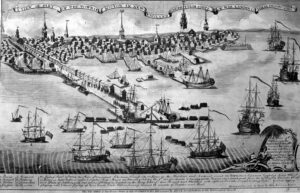
C. 1868
Engraving
1899.0024.001
In the fall of 1768, at the request of the British-appointed governor of Massachusetts, King George III sent 1,400 British troops to Boston to quell protests in a city increasingly seen as "ungovernable."
This engraving depicts British warships anchoring in Boston Harbor on September 30, 1768. The ships shown include the Beaver, Senegal, Martin, Glasgow, Mermaid, Romney, Launceston, and Bonetta, with notable landmarks such as Long Wharf and the Old State House in view.
At the height of the occupation, there was one British soldier for every four Boston residents. This marked a significant escalation in tensions between the city and the British Empire. Tensions that would culminate in the Boston Massacre just a year and a half later, on March 5, 1770, and ultimately contribute to the American colonies’ decision to declare independence from Britain.
Click here to view this object in our collection.
October 2025 - Mourning Ring
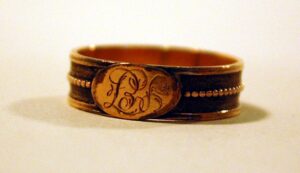
Mourning Ring
C. 1750-1800
Ring
1966.0010.002
With Halloween just around the corner, it's the perfect time to dig into some of the more curious traditions of the past, such as this mourning ring.
As early as the 16th century, it became customary in Europe to give out small tokens of remembrance such as gloves, scarves, and rings to friends and family of the deceased during funeral ceremonies. In Massachusetts, the trend really took off. So much so that by 1742, the Massachusetts General Court had to step in with legislation to rein in the rising cost of funerals. The new rules limited how many scarves and gloves could be handed out and limited the amount of wine, rum, and rings that was handed out.
This gold ring, dating from around 1750 to 1800, is inscribed with the initials “SEF,” referring to Samuel and Eunice Franklin. Most strikingly, it features a band of woven hair at its center. A deeply personal detail that was quite common in mourning jewelry of the time.
Click here to view this object in our collection.
November 2025 - Benjamin Franklin Miniature Portrait
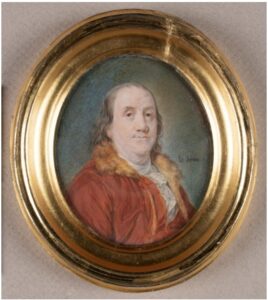
New Acquisition - Miniature painting of Benjamin Franklin
C. 18th Century
Attributed to Madame Elisabeth Louise Vigée-Le Brun, (French, 1775-1842)
We are pleased to announce a new addition to our collection this fall: a miniature portrait of Benjamin Franklin on ivory, attributed to Madame Élisabeth Louise Vigée Le Brun (French, 1775–1842). But this small Franklin portrait holds a big mystery: who really held the brush?
Check out our upcoming video series on social media @RevSpaces as we explore the possible artists, the intriguing signature, and the fascinating story behind this captivating miniature.
2024 Objects of the Month
March 2024 - Women's Silk Shoes
Eighteenth century
OSA #32
The work of merging the Old South Association and Bostonian Society collections has yielded a number of fascinating “discoveries,” as staff learn about objects previously unknown to us. One such item is this beautiful pair of eighteenth century women’s shoes. Lydia Remick Worster (1738-1820) wore the silk embroidered slippers at her 1760 wedding to John Sullivan. Sullivan would later become a distinguished Major General of the Continental Army. Born in Kittery, Maine, Lydia became a mother to six children, including George Sullivan, who would serve as a U.S. Congressman. The shoes do not have a label, but it is likely Lydia purchased them from a cordwainer (shoemaker) in London, as this style is similar to many imported into the colonies prior to the American Revolution.
April 2024 - Cane of Reverend Mather Byles
c. 1733
1906.0024
Reverend Mather Byles (1706-1788) was a Boston clergyman known not only for his skill in liturgical writing, but also his quick wit and poetic satire. He served as minister of the Hollis Street Congregational Church and may have received this cane as a gift upon his appointment there in 1733. The cap features an image of a hound chasing a rabbit and an inscription that reads, “M. Byles ex dono D Johannis Fitch 1733” (“ex dono” is Latin and translates to “a gift from”). A lifelong Loyalist, Byles once said, “Which is better—to be ruled by one tyrant 3,000 miles away or by 3,000 tyrants one mile away?” Although most Tories were driven out of Boston during the Revolution, Byles stayed until his death in 1788, remaining well-loved by Patriots and Loyalists alike for his humorous and affable nature.
Click here to view this object in our collection.
May 2024 - Broadside, “Saw Ye My Hero George” and “The Rosary” Lyrics
c. 1778
OSA-566
This broadside features the lyrics of two folk songs. The first song is unique for its time period in that there is surviving sheet music, giving modern researchers information about how it was sung at the time it was published. The song presents a narrative of Martha Washington searching for her husband George while he is away during the Battle of Monmouth. Although this did not happen in reality, the song creates a romantic storyline of a wife searching for her husband while he is engaged in a heroic fight. Martha also conveys her desperate wish for his protection. The song concludes with soldiers and civilians singing the praises of “victorious George” as they hail the conquering hero.
June 2024 - Postal Currency or Shinplaster
c. 1862
NN2008.0038
An unstable economy during the years of the American Civil War contributed to a coin shortage, as paper currency became devalued and practically worthless, leading citizens to hoard gold and silver coins. This created a predicament for business owners, as a lack of coins meant there was no way to provide change to customers. Shop clerks began giving postage stamps as change, but the stamps were not sturdy enough to make it through multiple transactions. Business owners thus began encasing the stamps, typically with an advertisement for their product or business on the case, like this currency which advertises “Burnett’s Standard Cooking Extracts of Lemon, Vanilla, Almond, Rose, &c. &c.” The local currency, known as shinplasters, was effectively outlawed by most states, but a solution was still needed. In response, President Abraham Lincoln passed the Postal Currency Act, authorizing a government version of the small denominations. Fractional currency in bill form began to be issued soon after, with the practice continuing until the 1870s.
Click here to view this object in our collection.
July 2024 - Lafayette Miniature
c. 1824
Gouache on ivory
OSA-612
Two hundred years ago, in the summer of 1824, the Marquis de Lafayette was invited by President James Monroe to visit the United States and mark the 50th anniversary of the nation’s founding. Lafayette proceeded on a whirlwind tour of all the states, totaling 24 at the time. Lafayette was given a hero’s welcome in all the cities he visited, including Boston, and many even dedicated streets or parks to him. A number of souvenir items were issued to mark the occasion, including this miniature porcelain gouache portrait.
August 2024 - Oliver Cromwell’s Head Tavern Bill
1785
Paper
1889.0023
Oliver Cromwell was an English statesman and soldier who led the overthrow of the English monarchy and execution of King Charles I in 1649. After ascending to power, Cromwell created The Protectorate to rule Britain and named himself Lord Protector in 1653, a position he held until his death in 1658. Upon his death, Cromwell’s son Richard ascended to power but lost control of the government in 1660, leading to the Stuart Restoration when Charles II ascended to the throne. With the return of the monarchy, Charles ordered that Cromwell’s body be removed from Westminster Abbey. His head was placed on a spike outside the Tower of London as a sign of disrespect, where it remained for thirty years. Although many saw Cromwell as a hero of liberty, those in favor of the monarchy believed him a villain. The Oliver Cromwell’s Head Tavern in Boston referenced the gruesome display, and this receipt from the tavern lists charges for boarding and liquor for a customer who stayed there in December 1785.
September 2024 - Eyeglasses
c. 1770
Lead and glass
OSA-25
Corrective lenses date to at least the 2nd century, when Ptolemy wrote about using a convex lens for vision correction in his treatise Optics. The invention of eyeglasses may have occurred in northern Italy during the second half of the thirteenth century. This pair was part of the Old South collection and dates to the 1770s. Unlike today, eighteenth century Bostonians had little choice in style of eyeglasses, so most pairs from this time period look very similar. Although, it is likely that most people were just happy to have better vision!
October 2024 - Fire Bucket with Image of Old South in Flames
c. 1873
Painted leather, metal
1922.0004.003
On November 9, 1872, a devastating fire ripped through downtown Boston. The Great Fire of 1872 would be the largest in Boston’s history, destroying 776 buildings and much of the financial district. As flames approached Old South Meeting House, a massive effort by firefighters and citizens was made to save the historic structure. This fire bucket was painted to commemorate that achievement, with an image of Old South and flames menacing in the background. Beginning in colonial times, many municipalities required homes and businesses to have fire buckets, as they served as an early form of fire extinguisher when fire was a constant danger to cities constructed of wood.
November 2024 - Broadside, A Proclamation for a Day of Thanksgiving by John Hancock
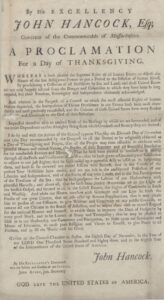 Broadside, A Proclamation for a Day of Thanksgiving by John Hancock
Broadside, A Proclamation for a Day of Thanksgiving by John Hancock
December 11, 1783
MS0119.DC2053
Thanksgiving was not a federal holiday until 1863 when Abraham Lincoln proclaimed the first celebration would take place on Thursday, November 26, in the midst of the Civil War. Although the day was not annually observed until that year, New Englanders were accustomed to days of Thanksgiving, perhaps beginning with that famous harvest feast in Plymouth in 1621. In the following years, New England governors, mayors, and ministers would regularly call for “Thanksgivings,” days of prayer to thank God for military victories and significant events, such as the signing of the Constitution. In 1783, John Hancock, Governor of Massachusetts, issued this broadside proclaiming December 11 a day to give thanks for the cessation of hostilities and the subsequent end of the Revolutionary War.
Click here to view this object in our collection.
2023 Objects of the Month
January 2023 - Benjamin Colman Sermon to Pirates
July 10, 1726
VAULT BV 4262 .C64
To kick things off, we have this sermon pamphlet, one of many from the eighteenth century in the Rev Spaces collection. Sermons were often written down and pamphlets of the transcriptions produced after the fact, so that churchgoers could experience their favorite sermons again, or discover new ones to aid in their religious education. This particular example was given by Benjamin Colman, on the occasion of the execution of pirate William Fly. Fly was an English pirate who was convicted of raiding New England merchant ships in 1726. He was put to death and his body hung in chains (gibbeted) on Nix’s Island in Boston Harbor, as a warning to other lawbreakers. Many consider Fly’s death to be the end of what came to be known as the “Golden Age of Piracy.”
Click here to view this object in our collection.
February 2023 - “Thompson the Abolitionist” Broadside
1835
MS0119.DC973.7114
On October 21, 1835, George Donisthorpe Thompson, a British abolitionist, arrived in Boston to give an anti-slavery lecture at the invitation of the Boston Female Anti-Slavery Society. The lecture was to take place at the offices of The Liberator, an abolitionist newspaper published by William Lloyd Garrison. This broadside reflected the popular opinion of much of Boston’s “respectable” society in that time period, who supported slavery and believed abolition would result in the destruction of the union. Approximately two thousand people (termed “highly respectable gentlemen” by local newspapers) gathered to protest. A riot ensued as protesters mobbed the office, searching for Thompson. Instead, they found William Lloyd Garrison, dragging him through the streets before the police rescued him, taking him first to Old State House, then to the Leverett Street Jail for safekeeping. The incident came to be known as the Boston Gentlemen Riot or the Garrison Riot and made national headlines.
Click here to view this object in our collection.
March 2023 - Sampler made by Lydia Hutchinson
1730
1885.0125
Samplers are works of embroidery that often contain a combination of letters, numbers, pictures, and rhymes. Young women and girls would often make samplers as part of their education during the eighteenth and early nineteenth centuries, typically as a way to learn letters and numbers while practicing their embroidery skills. Sewing was considered an essential skill for young women who were typically expected to manage their households as wives and mothers. This example was made by Lydia Hutchinson, sister of Thomas Hutchinson who would later serve as governor of the Province of Massachusetts Bay from 1771 to 1774.
Click here to view this object in our collection.
April 2023 - “Pick Up Sticks” Game Pieces
Nineteenth century
1937.0036.001-.038
These tiny wooden implements, playing pieces for a game of pick up sticks or jackstraw, were carved from wood salvaged from the John Hancock home on Beacon Street in Boston. The house remained in the family after Hancock’s death in 1793, but was ultimately sold in 1859 and torn down in 1863. Several building elements and wood scraps were salvaged, and a number of these items remain in the Revolutionary Spaces collection.
Click here to view this object in our collection.
May 2023 - Keystone (Corbel) from the Old State House
c. 1713
0005.1959.010
The exterior of the Old State House has a surprising feature hiding in plain sight! Circling each of the round windows are four unique faces carved in limestone. These keystones provide structural support for the window frames, but also reflect the creativity of the stonemasons. Each of the sixteen faces is completely unique. A young boy, old man, lion, and satyr are some of the faces that peer down to the street below. The originals were removed for safekeeping and now reside in the Revolutionary Spaces collection, but replicas can still be seen surrounding the four round windows, two on each end of the building.
Click here to view this object in our collection.
June 2023 - Print, Vue de Boston by Franz Xaver Habermann
1770s
2017.0001.001
This etching, likely created in the 1770s, is said to depict the Old State House and King Street (now known as State Street) in Boston, Massachusetts. Interestingly, nothing in the depiction is accurate; the artist was German and seemingly never visited Boston, nor did he use an accurate image of the city as reference. The print was made to be used with a zograscope, a device used to magnify and give depth to an image, hence the reversal of some of the text.
Click here to view this object in our collection.
July 2023 - Wooden Eagle Stern Carving
Nineteenth century
1914.0002.337
This majestic gilded carving of an eagle with wings outstretched in flight likely adorned the stern of a Boston fireboat in the nineteenth century. It was gifted to the Bostonian Society as part of a large donation of objects from the Boston Veteran Fireman’s Association in 1914. In the nineteenth century, carvings and paintings were often used both to decorate and identify fire engines and fire boats.
Click here to view this object in our collection.
August 2023 - Photograph of a couple riding a swan boat in the Boston Public Garden
1883
VW0001.002593
One of thousands of Boston images held in the Revolutionary Spaces collection, this photograph captures one of the city’s iconic swan boats just a few years after the first launching in 1877. Although the current boats are larger, the concept is the same, with passengers sitting on benches and a driver pedaling the pontoon boat with a paddlebox hidden inside a swan. Local businessman Robert Paget conceived of the idea after attending an opera, Lohengrin, in which a knight rescues a lady by riding a swan across a lake. The same family continues to operate the boats over 140 years later.
Click here to view this object in our collection.
September 2023 - Miniature of Ellen Maria Drury
Miniature portraits were a common way for wealthy individuals to carry a personal image of a loved one in the eighteenth and early nineteenth centuries. Prior to the popularization of photography in the 1850s, detailed miniature portraits were made by painting on ivory or porcelain. Like this one, they were sometimes framed and enclosed in a leather box with a clasp, to be carried in a pocket or bag.
Click here to view this object in our collection.
October 2023 - Mourning Earrings of Mrs. Roger Price (Elizabeth Bull)
In honor of spooky season, our object of the month is one of our more macabre pieces. The tradition of wearing mourning jewelry to mark the death of a loved one began in the seventeenth century, reaching its pinnacle in the nineteenth century. Many pieces included black jet (lignite coal used as a gemstone) or pearls (to symbolize tears). In addition, bereavement ornaments commonly contained woven hair of the deceased person as a memento, with hair woven into rings, earrings, brooches, or lockets. This particular set of earrings was worn by Elizabeth Price and may have been made to mark the death of her husband, Reverend Roger Price, in 1762. Reverend Price was a well-known Episcopal minister who served as rector of King’s Chapel in Boston.
Click here to view this object in our collection.
November 2023 - British Fireback
Firebacks began to be used in Europe in the fifteenth century. The heavy iron plates are used to protect the back wall of a fireplace and radiate heat into a room. This elaborately detailed example features a coat of arms with a knight and banners below a naval ship in bas-relief. The text reads, “The Brittish Navys Mighty Sound/ Strike’s Terrour to ye Nations Round.” The origin of the fireback is unknown, but the inscription suggests it may have belonged to a British naval officer. The object dates to the eighteenth century, but the text uses archaic forms of spelling and punctuation (such as “Brittish”) that date back to medieval (Middle) English.
Click here to view this object in our collection.
December 2023 - Photograph of Beacon Street after a snowstorm
1901
VW0001.000113
Happy holidays from Revolutionary Spaces! Click here to view this object in our collection.


